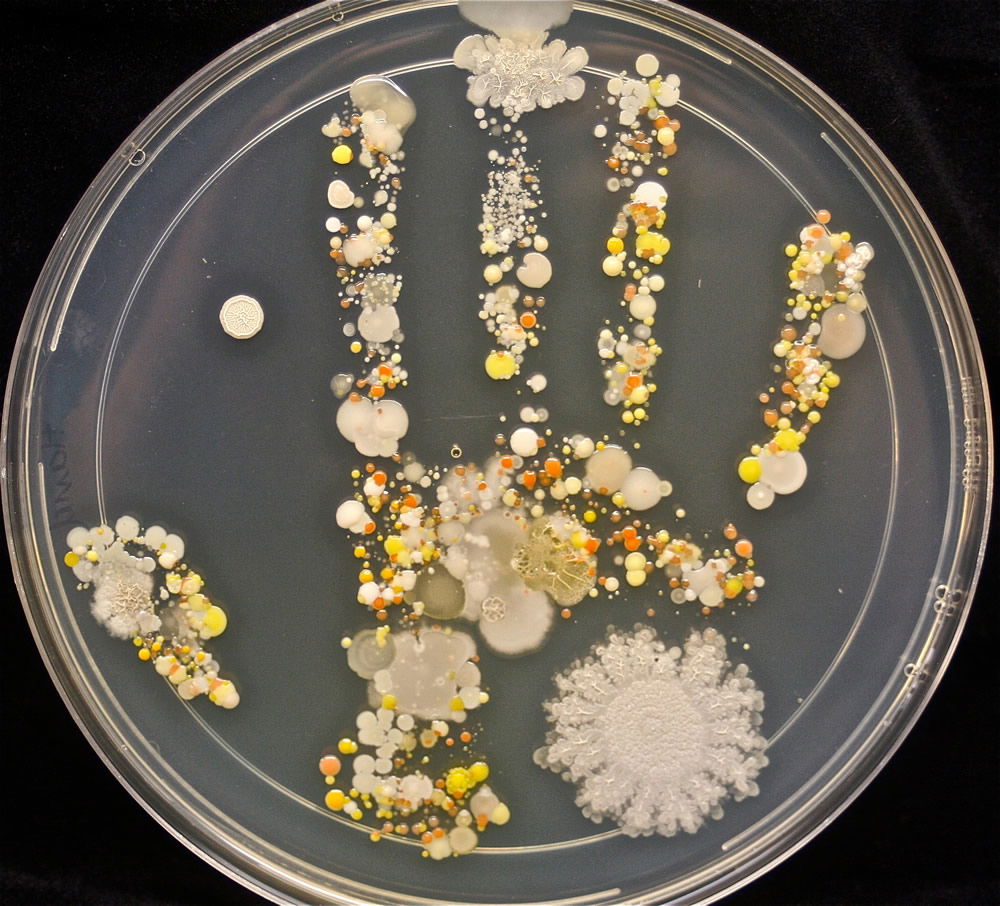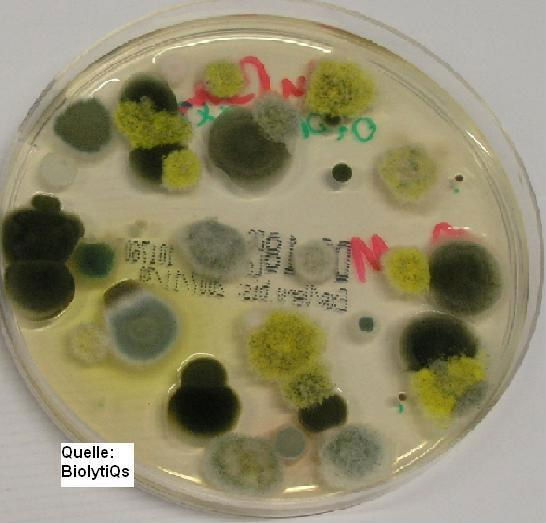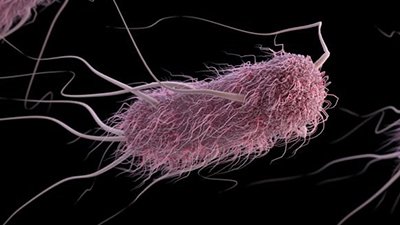How Bacteria Affect Your Everyday Life
Raise Your Hand . . . If You’re Sure Where You Got Your Microbiome
“Don’t touch that! You’ll soil it.” – Carl Fredricksen in Pixar’s Up
A few years ago, I went to a scientific meeting to present my research. When we got to the hotel, we checked in and discovered that our room was on an upper floor. When we boarded the elevator, I stepped on first and felt the social obligation to press the number for our floor. Without thinking twice, I did what I normally do when out in public: I used my elbow to touch the button for our hotel floor. And that’s when it happened: my friend chuckled to himself loud enough for me to actually hear it. When I turned back to see what he was laughing at, he quit chuckling almost immediately. It dawned on me after some reflection that he was actually laughing at me (not with me) for using my elbow to touch the elevator button.
In sharing this story, I want to calm all the germophobes reading this. I step up to the line of germophobia, but take one step back. We need to balance our understanding of the microscopic world because it is an essential part of and critically affects our everyday life. A recent study compared skin germs between humans and apes to better understand just how microbes affect our everyday life and personal hygiene in a genuine (though misguided) effort to further prove common ancestry. But before we can understand how the microbiome is part of God’s original creation and better appreciate His marvelous design (yes, even in our armpits!), we must first define some important terms.
Microbio-what’s-it?
Microbes are the earliest forms of life on earth.1 Biology is difficult enough, but microbiology presents a whole new challenge because it deals with organisms that you can’t even see with the naked eye. To clarify, think of microbiology as biology under a microscope. For us microbiologists, the living world we see without using a microscope is relatively boring compared to the unseen living world at the microscopic level (cf. Colossians 1:16). Bacteria are just one type of organism among many at the microscopic level.2 While diversity of life at the microscopic level is not only bacterial, most scientists generally refer to microbes as bacteria. The importance of referring to microbes with only bacteria in mind is important when describing the microbiome.
The word microbiome comes from the root word microbe. Anytime the letters -ome are added to the end of a word, the meaning of the word changes to mean “all of the” word appearing before it. So the microbiome includes all of the microbes for a given location. While sequencing the human genome was significant, sequencing of the human microbiome could be just as important, since the human body houses 10 bacteria cells for every single human cell. The microbiome is usually measured based on DNA sequencing of the 16S ribosomal subunit to generate what’s called a molecular signature.3 The molecular signature acts like a fingerprint to reveal the bacterial identity.

This image shows common environmental bacteria that are all good for a healthy immune system. It's okay to get dirty, but washing hands after using the bathroom and before eating are good hygiene practices and can prevent disease. Image courtesy of Tasha Sturm, Cabrilo College, via ASM Microbeworld.
Microbiome scientists are interested in questions such as “What bacterial species are present? And in what abundance?” Scientists think of microbiomes like a chef might think of food when planning to cater for a party. Chefs need to know both how many guests there are in addition to what type of food they like. At the microbial level, microbiome scientists measure the human microbiome by considering who is there and how many. The current scientific model of the microbiome follows the Baas-Becking hypothesis that “everything is everywhere, but the environment selects.” Therefore, scientists expect a certain degree of microbiome similarity between similar locations. But the contrast is also true: if two environments are different, then the microbiomes will be different. So how is our microbiome designed?
Your Designer Microbiome
Most people are horrified when they learn just how many bacteria live on and in us.4 Oftentimes, people react by actively disinfecting all of their personal things. Many are acutely aware of the bad germs surrounding them when they are sick. If we feel ill, we seek antibiotics. Ironically, we’re also supposed to eat lots of yogurt and take probiotics (good germs) on a regular basis—all in the name of health. We misunderstand health and sickness because we want to have our bacteria and kill them too. If we don’t understand the origin and purpose of bacteria, then we are downplaying God’s design and affecting our overall health. Is there a balance?

Mold growing in a petri dish. Image by Fumigatus, via Wikimedia Commons.
From the oceans to the soil to the human body, our planet could not exist without microbes. In Scripture, we learn that God first creates something and then He fills it (based on Genesis 1:2). Everything God made was mature, which means microbes were created in association with all of creation to benefit the earth. Dr. Joe Francis does an excellent job explaining the ubiquity and design of microbes with his concept of the biomatrix. The original “very good” creation must have included microbes because they are essential to life. So God created man with bacteria both inside and outside. We find myriad examples of beneficial bacteria in our intestine, and a growing body of evidence suggests that the bacteria on our skin also benefit and protect us.
Bacteria Are the Only Culture Some People Have
Confession time: one of my pet peeves is when someone gets a paper cut and overly worries that it will get “infected.”5 Truth be told, you were “infected” before, during, and after the paper cut.6 Bacteria that harmlessly live in association with us are called our normal microbiota.7 The normal microbiota of human skin is largely determined by a relatively high salt concentration (in case it’s been a while, try sucking your thumb to figure out just how salty it is).8 Actually, it is a wonderful design feature because the relatively high salt concentration creates an unfavorable environment for many bacteria, preventing major skin diseases. Furthermore, the same glands that produce the relatively high salt concentration also provide bacteria with nutrients. The fact that the same bacteria that can withstand a relatively high salt concentration can also thrive on the nutrients secreted by those same salt-producing glands screams that this skin-microbe symbiosis was designed. At the same time, though, these skin bacteria are also responsible for body odor. While you may not consider your body odor a wonderful design, there are additional points to consider.
In any biology textbook, you can find a chapter explaining how animals regulate their body temperature. When any creature’s temperature is outside acceptable limits, there are mechanisms to bring the temperature within normal limits. Our sweat glands lower our temperature through evaporative cooling, but some creatures lower their temperatures using a different mechanism. For instance, man’s best friend (the dog) does not have sweat glands to mediate evaporative cooling. Instead, when overheated, dogs pant heavily to cool themselves. Among the many things that evolutionists try to use as a similarity between humans and apes, they highlight the fact that we both have hair and sweat glands. But what they don’t tell you is how gloriously different our Creator God made us.
While monkeys and apes have skin glands, it is important to note the difference in the location and type of basic skin glands between humans and apes. There are three basic types of skin glands: apocrine, eccrine, and sebaceous glands. The difference between human skin and ape skin is striking.
The distribution, function and secretion of the different types of human skin glands (sebaceous, apocrine and eccrine) are briefly described. . . . Eccrine glands are the best developed and most abundant glands in humans and are widely distributed over the general body surface. By contrast, in most mammalian groups (including prosimians, monkeys and apes, with the exception of great apes) eccrine glands are limited to the friction surfaces of the hands, feet and tail. Apocrine glands, which play an important role in chemical communication, have a restricted distribution in most mammals including humans. . . . All prosimians, monkeys, and apes have thermal apocrine glands associated with hair follicles. The chimpanzee and the gorilla exhibit a distribution ratio . . . [only slightly different from] . . . monkeys, the gibbon, and orangutan. . . . By contrast, humans mainly possess eccrine and relatively few apocrine glands.9

You should cry “foul” when anyone tries to compare human skin to any monkey or ape skin because the similarities are just too few. Regardless of these major differences, scientists recently decided to analyze the armpit microbiomes from humans, chimpanzees, gorillas, baboons, and rhesus macaques.10 In the article, the authors even admit that “the composition of microbes on human skin might be expected to differ significantly from that of our closest relatives, the non-human primates, for at least three reasons.”11 As creationists (and scientists), we expect to find differences based on empirical science. The Baas-Becking hypothesis previously mentioned says similar microbes are found in environments that are similar. Since the environments in armpits of humans and apes have (1) completely different glands, (2) different chemicals secreted, and (3) different concentrations, then the logical expectation based on empirical science is to find significant differences between the skin microbiome of humans and primates (as well as differences in the armpit microbiomes on other animals, because humans were created uniquely from the rest of creation). The only people committed to expecting strong similarities are Darwinists because (and only because) they are committed to a worldview despite empirical evidence to the contrary. Not too surprisingly, the Darwinists were surprised. What did they find? The armpits between humans and apes have few similarities and carry different bacteria. The assortment and diversity of bacteria found in different microenvironments are not surprising between humans and apes when you acknowledge the unique design of each creature and approach science without the wrong presuppositions. The differences between human microbiomes and ape microbiomes are so unique that mosquitoes detect these differences and prefer feeding from certain creatures (i.e., humans) over others (i.e., everything else).12
Want to tell the difference between human and monkey sweat? So easy, even a mosquito can do it!
If even mosquitoes can tell the difference between the human and ape microbiomes, then how do evolutionists interpret the empirical evidence to fit their worldview? The authors of this microbiome study (along with other evolutionists) claim that the evolution of personal hygiene is the culprit. A recent article proposes that we should only shower once a week because we’re “harming” the environment due to personal hygiene products.13 Furthermore, we are often told that the reason humans groom each other is because of our evolutionary history of apes grooming one another. But when you scientifically examine ape-grooming behavior, the irony is that they actually groom out of fear; it is a dominance behavior.14 And when you scientifically examine any other evolutionary claim, you find yourself trying to work out of an armpit existence. Evolution is foul smelling, dark, and damp because it is logically incoherent. Creationists are not surprised to find differences between human and ape skin microbiomes because we are not committed to a worldview claiming humans and apes share common ancestry. As a result, creation scientists are open-minded to existing differences and can ask more sophisticated questions aimed at understanding the skin microbiome and improving health.
The next time you work out, engage in physical activity, or otherwise find yourself sweating, wipe your brow in praise to our Creator who gave us everything we need in our existence. Don’t sweat the small things in life. Keep a cool head. Even as seemingly gross as the microbiome is in this fallen world, there is no doubt that our loving Creator fashioned it to help us when things get tough.
Footnotes
- Accepting the biblical account, of course, this would only be a matter of days, not millions of years. See Alan Gillen, “Microbes and the Days of Creation,” Answers Research Journal 1 (2008): 7–10, https://answersingenesis.org/days-of-creation/microbes-and-the-days-of-creation/.
- Microbes are usually sub-divided into two main categories: prokaryote and eukaryote. The modern evolutionary classification system further divides those into the archaea, eubacteria, and eukaryota. Within each of those three domains of life, there are further sub-divisions. I want to emphasize that I am paying a disproportionate level of attention to the bacteria within all the vast microbes that God made.
- There are many different approaches to measuring the microbiome. However, those other approaches are not frequently referred to when citing the human microbiome or the microbiome belonging to something else. For simplification and clarity, I will use microbiome to specify the specific identification technique using bacterial 16S rRNA genes.
- MythBusters did a really great episode looking at supposedly dirty places in public areas. They show the places they swabbed and how “dirty” they actually were. I highly recommend it for the entertainment value and a fairly accurate treatment to understand the common places where you can find germs. An important consideration in human infectious disease is that we usually make ourselves sick by touching our face before we wash our hands. Vigorous hand washing is not necessary at all times, just before meals and when you get back home. In case you haven’t noticed, you didn’t catch strep throat because you stayed at home in utter isolation.
- In general, I think our society is too afraid of germs. I don’t advocate living like slobs, but I think that we shouldn’t live in total fear of the normal germs around us.
- Nearly everyone carries Staph on them somewhere. It is important to note that while Staph is the most abundant, there are over 20 species of Staphylococcus spp. Simply calling something a Staph infection carries little true, clinical meaning.
- Some of the primary microbes on human skin are Micrococcus spp., Staphylococcus spp., and Corynebacterium spp. For further discussion of the Staphylococci, see Alan Gillen, “The Genesis of Methicillin-Resistant Staphylococcus Aureus,” Answers in Depth 4 (2009): https://answersingenesis.org/natural-selection/antibiotic-resistance/the-genesis-of-methicillin-resistant-staphylococcus-aureus/.
- While many factors affect bacterial growth on skin, the most significant growth determinant is the salt content.
- Renate C. Smallegange, Niels O. Verhulst, and Willem Takken, “Sweaty Skin: an Invitation to Bite?,” Trends in Parasitology 27, no. 4, (2011): 1–6, doi:10.1016/j.pt.2010.12.009.
- I can imagine how difficult and awkward it must have been to collect samples for human volunteers. I cannot fathom what it must have been like to stick a Q-tip up the armpit of a gorilla, but I so wish they had recorded it and posted it on YouTube because it would’ve been hilarious. I would not recommend sticking your finger in the armpit of any primate under any circumstance—unless you want a 6-foot, 400-pound gorilla chasing you!
- Sarah E. Council et al., “Diversity and Evolution of the Primate Skin Microbiome,” Proceedings of the Royal Society B (2016): doi:10.1098/rspb.2015.2586.
- Renate C. Smallengange, “Sweaty Skin: an Invitation to Bite?”
- Donnachadh McCarthy, “I Shower Once a Week. Here’s Why You Should Too,” Guardian, March 8, 2016, http://www.theguardian.com/commentisfree/2016/mar/08/shower-once-a-week-polluting-environment.
- University of Groningen, “Primates’ Social Intelligence Overestimated: Primates Groom Others If Afraid They’d Lose Fight,” ScienceDaily, January 11, 2010, https://www.sciencedaily.com/releases/2010/01/100107083909.htm.
Recommended Resources

Answers in Genesis is an apologetics ministry, dedicated to helping Christians defend their faith and proclaim the good news of Jesus Christ.
- Customer Service 800.778.3390
- Available Monday–Friday | 9 AM–5 PM ET
- © 2025 Answers in Genesis






